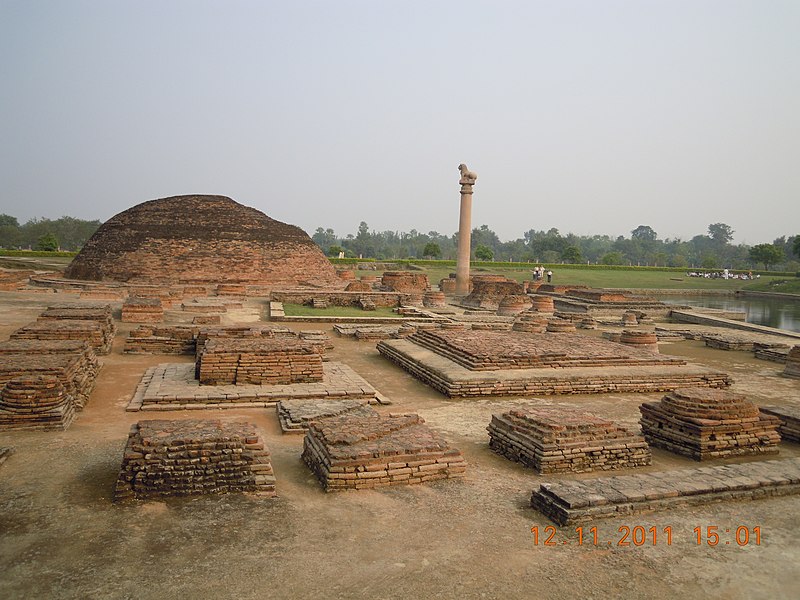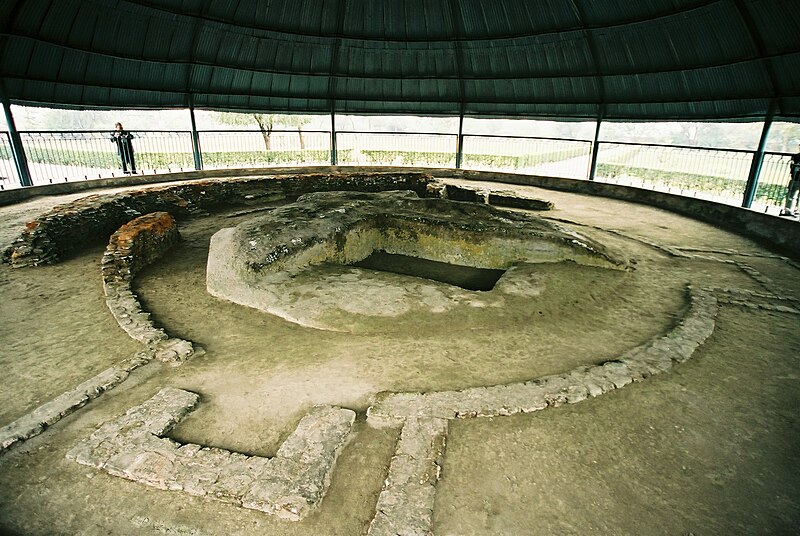(Vesali, Vesālī, Vesāli, Veshali, Veśālī)
Lord Buddha visited Vaishali thrice and spent long time here. The famous Ratana Sutra was delivered by the Lord in Vaishali. Towards the end of his life, Lord Buddha announced parinirvana and delivered his last sermon here in Vaishali. The Second Buddhist Council was held at Valukarama monastery, near the city of Vesali about 100 years after Lord Buddha’s death. Emeror Ashoka comemorated the site by building stupa and a Ashoka Pillar with lion capital which still stands proud at the site. in 2010, the site was included in tentative list of UNESCO Word Heritage Centre under Silk Road Sites in India.

| IMPORTANCE OF THE PILGRIMAGE SITE OF VAISHALI |
| 1. The site of Vaishali is further south of Champaran. During Buddha’s time, Vaishali was ruled by Lichhavis and Magadh was ruled by Bimbisara of Haryanka dynasty whose capital was Rajgir. Bimbisara’s son Ajatshatru later annexed Vaishali into Magadh and also shifted Magadh’s capital to Patliputra. Both Bimbisara and Ajatshatru were Buddha’s followers. Buddha is said to have visited Vaishali thrice and spent long time here. |
| 2. Ratana Sutta रतन – सुत्त : In Vaishali (Vesali), Lord Buddha had delivered Ratana Sutta (Discourse on the Jewels) to the Venerable Ananda, and had instructed him to tour the famine afflicted city of Vesali with the Licchavi citizens reciting the discourse as a mark of protection to the people of Vesali. {RATANA SUTTA रतन – सुत्त |Text Pali Sanskrit English English detailed | Videos by Priya Barua , by students of Mumbai University , Animated version , by Imee Ooi } |
| 3. Towards the end of his life, Buddha announced his parinirvana and delivered his last sermon here in Vaishali. |
| 4. विमलकिर्ति Vimalakirti, Buddha’s famous disciple was from Vaishali; famous for विमलकिर्ति निर्देश सूत्र (Vimalakirti Nirdesa Sutra).{ विमलकिर्ति निर्देश सूत्र Vimalakirti Nirdesa Sutra |Text 1|Text 2 | Short biography of Vimalakirti | भूमिका Introduction | All 14 Chapters | Explanation by Robert Thurman | Resources } |
| 5. Vaishali is the place where second Buddhist council was held at Vālukārāma (वालुकाराम) monastery or Walukarama temple, near the city of Vesali, about 100 years after Buddha’s death under the patronage of Kalashoka, the son of Shishunaga. Valukarama, Vālukārāma, Valuka-arama : As recorded in the Pāli Buddhist texts, Vālukārāma (वालुकाराम) monastery (ārāma) was situated in Majjhimadesa (Middle Country), in Vesali, of ancient India where the question of the Ten Points raised by the Vajjiputta monks was settled. It was also the dwelling place of Upali, Dasakas teacher. According to an independent researcher, the present Bhagwanpur (25° 56’ 39 N, 85° 07’ 16 E) village in Raghopur river island in Ganga in Vaishali district is likely to be the actual site of Valukarama Monastery where second Buddhist Council was held. The researcher writes, “The 2nd Council meeting place was the first place mentioned by Xuanzang as he left Vaishali. This site is located 15 Li south-east of Vaishali. At the site of the council, he mentioned a great stupa (See fig. 2). According to Xuanzang, two different conversions of Li were given in his accounts. 15 Li is between 4.5km (1 Li=300 m) to 6 km (1 Li= 400 m) Within this distance range from Vaishali, are located a group of villages, with Bhagwanpur (25° 56’ 39 N, 85° 07’ 16 E) being the most suitable place among them to match Xuanzang’s description. Bhagwanpur Village is settled on a big mound spread over a large area. In the western corner of the village is a tank (pond) and by its side is big stupa shaped mound (Fig 3 and 4). On top of the mound is a temple. The temple is very popular among the locals”. (Place of 2nd Council – Nālandā – Insatiable in Offering) |
| 6. In order to comemorate association of Vaishali with Lord Buddha’s life, Emperor Ashoka constructed stupa and erected Dhamma Stambh (Ashokan pillar). The Dhamma Stambh beside the brick stupa at Kolhua in Vaishali commemorates Lord Buddha’s last sermon. There is no Ashokan edict engraved on the pillar. |
| 7. In 2010, Kolhua site comprising of remains of Kutagarshala, Swastika-shaped monastery, a tank, cluster of votive stupas, miniature shrines, main stupa and the Ashokan Pillar was put in tentative list of UNESCO Word Heritage Centre under Silk Road Sites in India. |
Buddha’s Relic Stupa
Buddha Relic Stupa, enshrining one of the eight parts of ashes (mortal remains) of Lord Buddha), is one of the holiest pilgrimage sites. It is ASI protected site in Vaishali. The Stupa was built by Lichhavis as a mud-stupa in the 5th century BC.
The stupa was discovered in an excavation during 1958-1962. The relic casket excavated from the core of the stupa contained the holy ashes of Lord Buddha mixed with earth, a piece of conch, pieces of beads, a thin golden leaf and a copper punch-marked coin. The casket was brought to Patna Museum in 1972 where it is kept for preservation.

GEOGRAPHICAL LOCATION:
| Country | India |
| State | Bihar |
| District | Vaishali |
| Village | Kolhua |
| Postal Code | 844128 |
| Coordinates | 26.014162°N 85.109220°E |
| Google map link | https://goo.gl/maps/4d8XhGMY5z3tv7rMA |
GOOGLE MAP:
Kolhua Ashok Pillar
THE EDICTS OF ASHOKA:
The Ashokan Pillar at Kolhua does not bear any edict
________________________
SOURCES:
1.Indian Archaeology 1957-58 A Review Excavation at Vaishali, District Muzaffarpur Pages 19-20
2.Indian Archaeology 1990-91 A Review Excavation at Kolhua, District Muzaffarpur Pages 11-12
3.Indian Archaeology 1991-92 A Review Excavation at Kolhua, District Muzaffarpur Pages 13-14
4. UNESCO World Heritage Centre. Tentative Lists – Silk Road Sites in India. Ruins of Ancient Vaishali
5. An Early History Of Vaisali by Mishra,yogendra (pdf version)
***
SELECTED VIDEOS:
***
